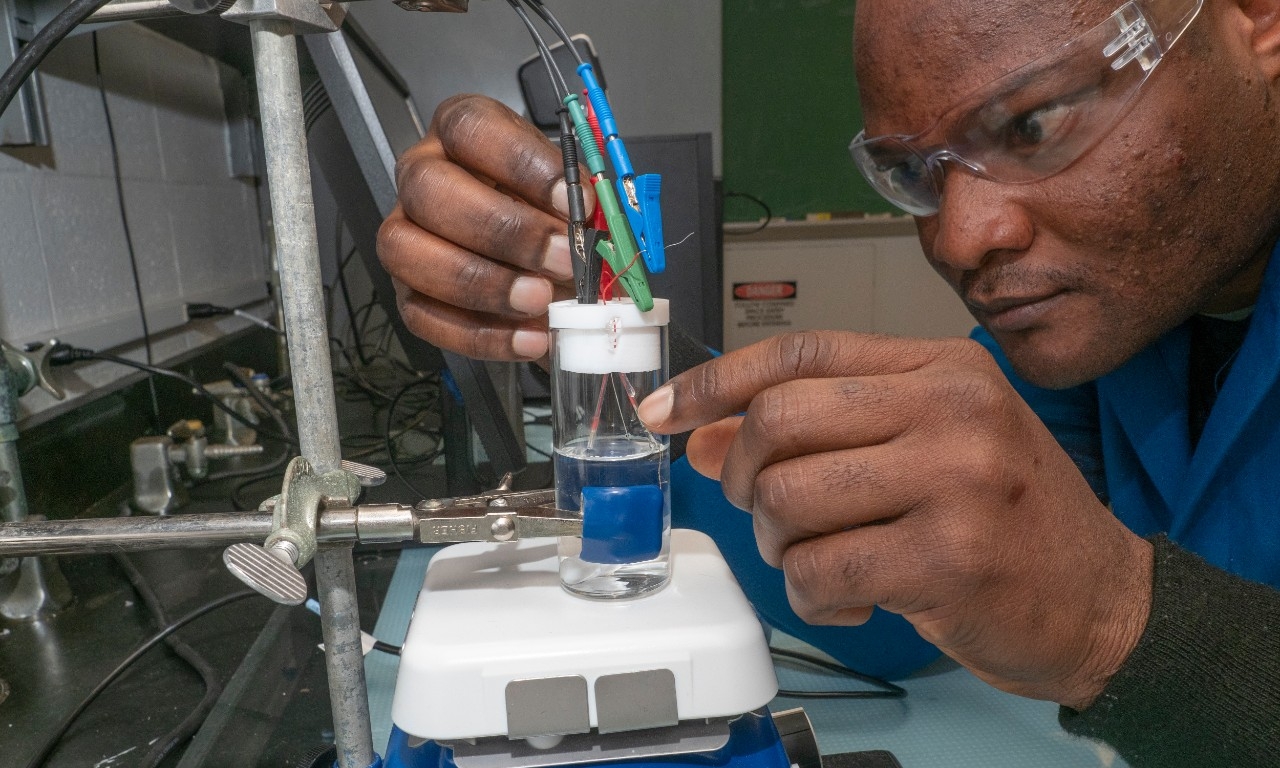By Michael Miller
Photos by Jay Yocis

he problem with lead is that it’s so hard to detect.
The heavy metal is found in everything from paints and ammunition to car batteries and antique toys. Malleable, cheap and abundant, lead was a favorite material for pipes and plumbing fittings dating back to the Roman Empire. But it’s also toxic, so toxic that exposure can cause lifelong cognitive and neurological impairments in children.
“Lead toxicity has been known since the 1700s. This problem has plagued us for two centuries. Why don’t we have a solution?” asks Noe Alvarez, a professor at the University of Cincinnati.
Alvarez isn’t a toxicologist. He’s a chemist who works closely with UC’s chemical engineers. Naturally, he thinks of lead in drinking water as a problem that needs a chemical engineering solution.
Alvarez and his colleagues are using nanotechnology to develop a new household appliance, a continuous water monitor that will alert users if lead or other heavy metals are in their tap water.
“I don’t want to scare people but it is scary, especially for young children,” Alvarez says. “Lead affects the developing brains of children. The impact on society is huge. It’s heartbreaking.”
The recent water crisis in Flint, Michigan, demonstrated how dangerous lead can be when a change in service inadvertently corroded miles of pipes and exposed 100,000 people to toxic lead in their faucets.
“It’s a problem for our whole society,” Alvarez says.

UC assistant professor Kolade Ojo adjusts a carbon nanotube water sensor in a chemistry lab.
He is using carbon nanotubes in his lab that are 1,000 times smaller in diameter than a human hair to identify and measure lead and other heavy metal toxins such as mercury and cadmium in water. Ultimately, his goal is a simple detection system that would attach to a faucet and indicate when the water is safe. Armed with this device, parents could run the faucet until the water is clean again or decide whether to replace plumbing responsible for the contamination.
People have known for centuries that lead is dangerous. Ben Franklin even penned a letter in 1786 identifying the “mischievous effects” of lead paint and the dangers to workers in his lead typesetting industry.
More recently, within the past 20 years, doctors have discovered that even mild lead exposure can impair a child’s cognitive development. Health officials once considered anything higher than 10 micrograms per deciliter of blood to be of concern. They narrowed that standard to 5 micrograms in 2012 and are now pushing to reduce it even further — to 3.5 micrograms.
The power of nanotubes lies in their sensitivity, UC assistant professor Kolade Ojo says. They have a large surface area, are highly conductive and can measure a wide spectrum of change, which makes them perfect for sensors.
“This research is so exciting for me,” Ojo says. “The goal here is improving the lives of children. Most people don’t even know when their children have been exposed to lead.”
The Environmental Protection Agency considers anything higher than 15 parts per billion to be unsafe for consumption in public drinking water. UC’s sensors are so sensitive they can measure lead concentrations as low as 1.7 parts per billion.
“You want to go as low as possible so that even the smallest concentrations of lead in water are detected by sensors. That’s the goal,” Ojo says.
22 million
people in the U.S. are affected by lead in drinking water
Lead affects as many as 240 million people globally, according to the World Health Organization. In Ohio alone, 4,717 children tested last year had lead concentrations of 5 micrograms or higher in their blood. Dozens test higher than 45 micrograms, which requires medical treatment and spurs immediate intervention to prevent further exposure. And as many as 22 million people across the United States have lead pipes in their community water lines, according to a 2016 study by the American Water Works Association.
Epidemiologist Kim Dietrich with UC’s College of Medicine has studied lead exposure and toxicity for 40 years. He oversees the nation’s longest-running study of lead’s toxic effects. (Dietrich even consulted on an episode of NBC’s “Law and Order” in which the defense argued that lead poisoning mitigated an impulsive homicide by a young defendant.)
Dietrich says UC’s research to prevent exposure to lead in drinking water has promise.
Lead inhibits development of the frontal lobe, the part of the brain responsible for critical thinking and reason, Dietrich says. Studies have found that lead can reduce fertility, diminish IQs and lead to higher rates of death from cardiovascular disease. Dietrich’s research has found that children exposed to lead are even more likely to commit crimes in adulthood.
The goal here is improving the lives of children.
—Kolade Ojo, UC postdoctoral fellow
“Lead attacks the central nervous system, leading to behavioral, cognitive and neurological issues,” Dietrich says. “We have found that lead impacts parts of the brain associated with judgment, emotional regulation, and self-monitoring — or what neuropsychologists call ‘the executive functions.’”
Lead-based paint in older homes and businesses is by far the biggest culprit of lead contamination, both in Ohio and across the United States, Dietrich says. Parents can limit the harmful effects of lead by feeding their children a diet rich in iron, calcium and vitamin C, which can prevent their bodies from absorbing the heavy metal.
“There is no reason to believe children who are poisoned with lead cannot improve,” he says.
The Greater Cincinnati Water Works identifies every known lead water pipe in an online searchable map, marking each property with color-coded boxes: yellow for lead pipes and green for none. Some older neighborhoods in Cincinnati look like they’re covered in lemon confetti.
“Lead has a lot of great characteristics for plumbing. It bends. It’s inert. It doesn’t corrode. But toxicity is its major downfall,” says Jeff Swertfeger, water quality superintendent for the Cincinnati utility.
A home warning system like the one UC is developing would be hugely beneficial in helping parents prevent lead exposure, Swertfeger says.
“Absolutely, having a sensor would give people peace of mind,” Swertfeger says. “And having that real-time information about lead in the water also would help us understand the risk in our community so we would know where we should invest limited resources to attack the problem.”
UC chemistry professor Noe Alvarez holds up a spool of carbon nanowire fiber.
Replacing old lead pipes costs the average homeowner about $5,000. Swertfeger says the utility offers some subsidies and 10-year financing to make replacement more affordable. Likewise, the water department is asking the Ohio Department of Commerce to add notifications to real estate transfers so that prospective homebuyers know whether a house has lead pipes. Four states already do this.
“I might be a little nuts to try to solve a problem that hasn’t been solved in 200 years,” Alvarez says. “But so far, I’m encouraged by the results.”
His team of student researchers at UC is helping to develop a viable commercial product.
“We can help children who are drinking contaminated water, not just at home but in daycares and schools,” UC graduate student Connor Rahm says.
He wants to build a new business around the technology. Working on a project with the potential to help so many people is hugely rewarding for students.
“It’s a great motivator,” Rahm says. “It makes you feel like you’re working toward something bigger than yourself.”

Michael Miller is a public information officer at the University of Cincinnati and contributes to UC Magazine.
Additional Credits: Thanks to photographers Jay Yocis and Ravenna Rutledge, designer Benjamin Gardner as well as web developers Kerry Overstake and Rebecca Sylvester for helping to develop and present the content contained in this piece.
Researcher takes innovative approach to detect lead in drinking water using carbon nanotubes.
The School of Information Technology at UC is leading the charge in Ohio to strengthen the state’s cybersecurity capabilities and talent pipeline.
Journalism student Alberto Jones shares his Boldly Bearcat story about surviving abuse to chase his dream of becoming the next Oprah.
UC’s unconventional scientist tackles remedy for cystic fibrosis and COPD with solution that could have worldwide impact.
UC prepares to celebrate its Bicentennial in 2019 — honoring the past, elevating the present and bending the future.
President Neville Pinto: Seeking the 'new and next' as UC turns 200